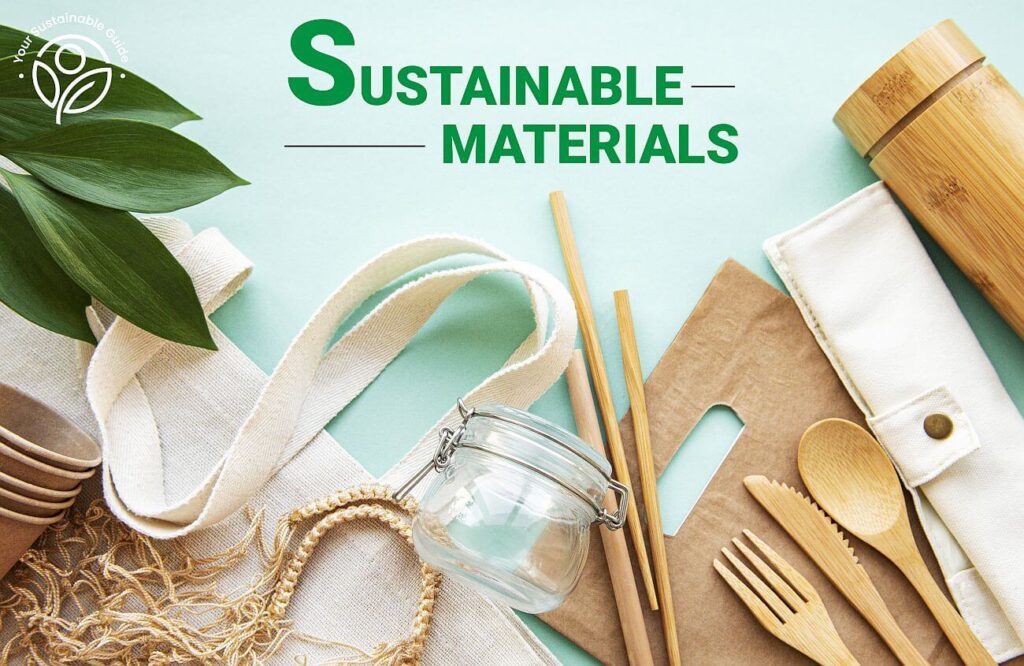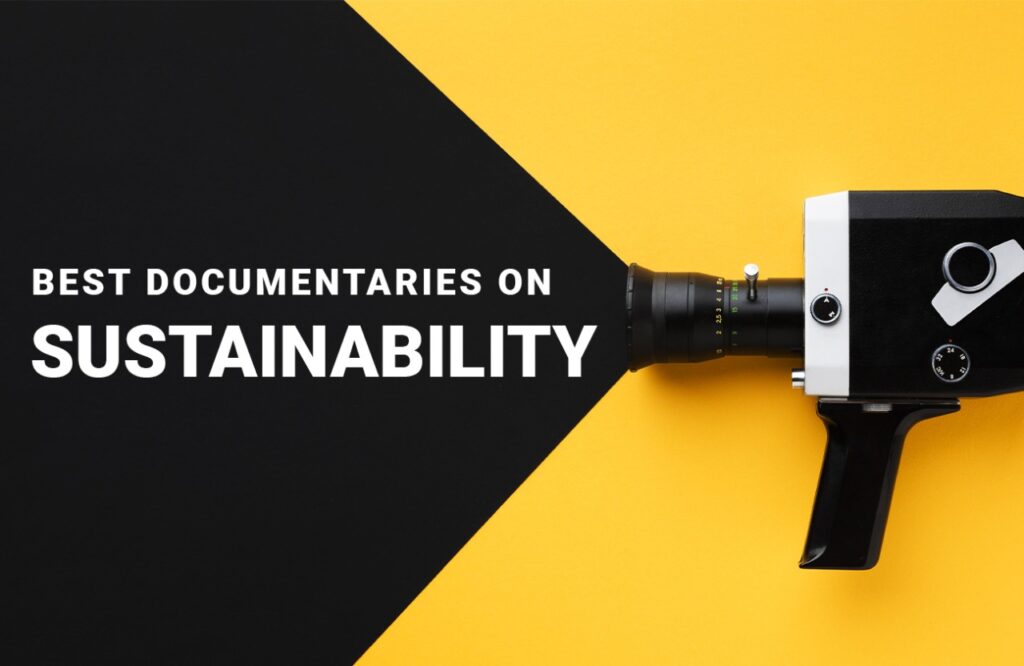Amidst rising climate change and economic challenges, sustainability has evolved from a buzzword to a lifestyle commitment for people striving to reduce their carbon footprint. In today’s fast-paced and environmentally-conscious world, being informed about the materials used in our everyday products is vital. Because our mindful consumption behavior can make a significant difference, conveying a message to industries about the demand for sustainable materials. But what exactly makes a material sustainable? How can they contribute to safeguarding our planet? Don’t worry; the answers you seek are right here!
Let’s explore the world of sustainable materials, learn about their importance and diverse benefits across various industries.
Harnessing the Power of Sustainable Materials for a Bright Future

Sustainable materials hold the key to building a more environmentally-conscious world. The way we use materials today determines our economic and environmental future. As the global population and economies expand, the competition for limited resources will increase. Using materials more efficiently and responsibly not only helps our society stay economically competitive but also ensures prosperity, defending the planet in a future with limited resources. By embracing the benefits of sustainable materials and encouraging innovative advancements, we can support industries that are adopting eco-friendly practices and encourage responsible consumption behavior.
Types of Sustainable Materials
Natural Materials
Natural materials are gifts from Mother Earth, sourced directly from nature itself. Typically, these include materials that are grown, such as wood, bamboo, cork, and cotton, or are extracted through mining, like stone, clay, and metals. Each of them bears unique properties and are utilized in various industries and products. These materials stand out not only for their versatility but also for their biodegradability and minimal ecological impact. Unlike synthetic counterparts, natural materials can be safely returned to the earth, contributing to a waste-free circular economy.
Renewable Materials
Renewable materials are derived from resources that can be easily replenished or regrown, either by people or in nature. To be truly renewable, a material must have the ability to naturally restore what is used, at a rate that allows it to be sustained over time, without depletion. An example of a natural renewable material is bamboo, which grows rapidly and can be harvested sustainably. On the other hand, man-made recycled materials, like glass, can be infinitely reused without losing their quality. These renewable materials play a crucial role in promoting sustainable practices across various sectors, from construction and packaging to textiles and energy production, as they ensure a more balanced approach to resource consumption and management.
Non-Toxic and Harmless Materials
Non-toxic materials are essential for both human health and environmental well-being. Numerous materials, whether natural or synthetic, are often processed or treated with toxic chemicals that pose risks to people, animals, and our planet. These toxins can persist long after application, leading to challenges in safe disposal. Opting for eco-friendly alternatives, such as low-VOC paints and biodegradable plastics, can significantly reduce the adverse impact on our surroundings. As awareness of sustainability grows, there is an increasing demand for harmless materials in various consumer products.
Benefits of Sustainable Materials
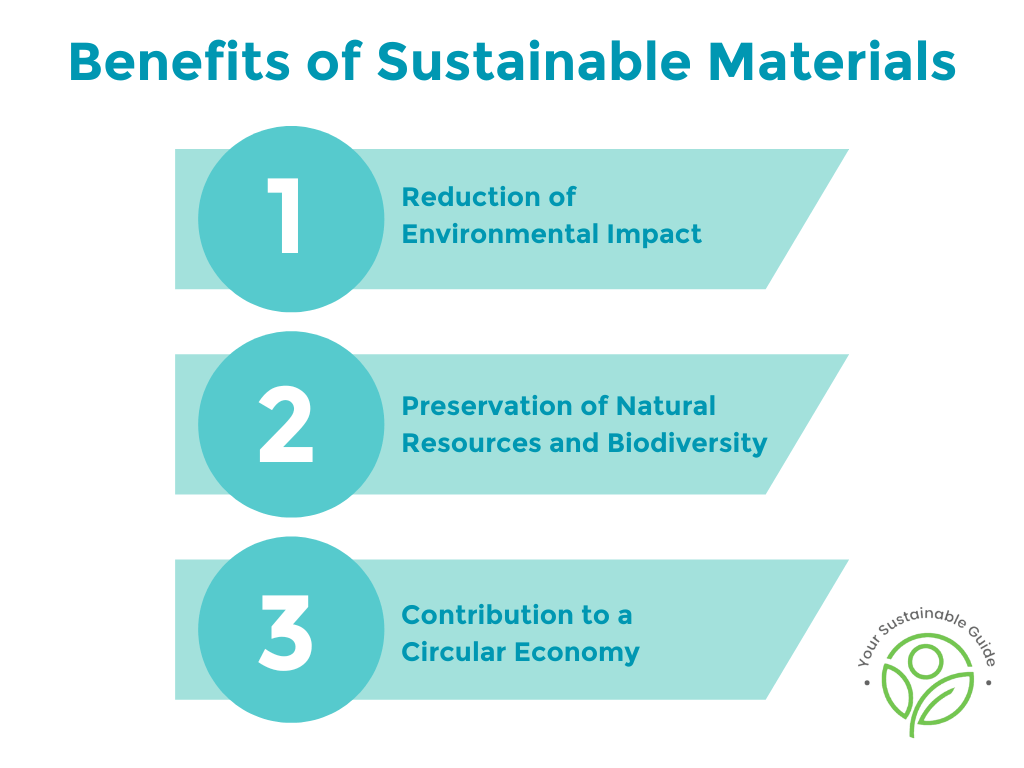
Reduction of Environmental Impact
Sustainable materials are produced using eco-friendly practices, emitting fewer greenhouse gas emissions and consuming fewer resources compared to traditional materials, thereby mitigating climate change effects.
Preservation of Natural Resources and Biodiversity
Sustainable raw materials are usually sourced from renewable or recycled materials, reducing the pressure on finite resources. By utilizing materials that do not deplete natural habitats, we can safeguard biodiversity and support the long-term health of ecosystems.
Contribution to a Circular Economy
Eco-friendly materials are designed to be recycled, reused, or biodegraded at the end of their life cycle. Therefore, working with these materials encourages a circular economy, where waste is minimized and resources are continuously regenerated. This approach cuts out the burden on landfills and promotes more responsible business operations.
Sustainable Building Materials

Using sustainable, recycled, and reclaimed materials in construction and architecture helps reduce the demand for new resources, minimizing the strain on natural ecosystems. It also diverts waste from landfills, enhances energy efficiency, and supports responsible consumer choices. Incorporating biodegradable and bio-based materials ensures that buildings have a lower ecological impact and can naturally decompose at the end of their life cycle, reducing long-term environmental harm. Some of these low-impact building materials are:
Wood
Wood is a widely-used sustainable building material due to its renewability, low carbon footprint, and biodegradability. It is commonly used for framing, flooring, siding, and interior finishes. Besides its natural aesthetic appeal, wood contributes to a healthier indoor environment by regulating humidity levels and improving air quality. Sustainable forestry regulatory bodies like the FSC, ensure responsible wood sourcing, promoting forest management and biodiversity.
Bamboo
Bamboo is an exceptionally fast-growing and renewable resource, making it an eco-friendly alternative to hardwoods. It is highly versatile and utilized for flooring, walls, furniture, and even structural elements in some cases. Bamboo’s strength-to-weight ratio makes it ideal for various construction applications, and its rapid growth rate means it can be harvested sustainably without depleting resources.
Straw Bales
Straws have been a part of building houses for ages. They are versatile, provide excellent insulation, and are often used for constructing walls. Plus, straw bales are renewable, biodegradable, and sourced from agricultural by-products, eliminating waste. Their low cost and ease of construction make them ideal for eco-conscious building projects, especially in rural areas.
Adobe
Adobe is an ancient building material made from mud, dung, straw, and water. It is sun-dried to form bricks used for walls and structures. Adobe provides excellent thermal mass, effectively regulating indoor temperatures in both hot and cold climates. It’s low embodied energy and minimal environmental impact make it an eco-conscious choice for sustainable construction.
Cob
Cob is a traditional and sustainable building material composed of a mixture of clay, sand, straw, and water. It is sculpted by hand to create walls and structures. Cob buildings have excellent thermal mass, providing natural temperature regulation and energy efficiency. The use of locally-sourced materials and minimal energy-intensive processes make cob construction a popular choice for eco-friendly and environmentally responsible building projects.
Reclaimed or Recycled Steel
Reclaimed or recycled steel is obtained from salvaging old structures or products, reducing the need for energy-intensive primary steel production. This practice helps conserve natural resources, lower greenhouse gas emissions, and minimize resource waste. Recycled steel is commonly used for structural support, reinforcing concrete, and constructing frameworks in eco-friendly buildings.
Reclaimed Wood
Reclaimed wood is salvaged from old buildings, barns, excavation firms, or discarded furniture, giving it a second life in sustainable construction. It adds character and history to spaces while promoting a circular economy by reducing the demand for new wood. Reclaimed wood can be used for flooring, siding, paneling, and various decorative elements, showcasing both environmental responsibility and aesthetic charm.
Recycled Plastic
Plastic pollution is one of the biggest problems we face today. But recycled plastic can be the solution. Utilizing discarded plastic waste not only helps to cut plastic pollution but also decreases the demand for virgin plastic production. Recycled plastic can be molded into various construction elements like lumber, roofing tiles, and insulation. It exhibits durability and resistance to pests, moisture, and decay, making it a durable and sustainable option for construction applications.
Precast Concrete Slabs
These concrete slabs are manufactured off-site and delivered to the construction area in whole sections ready for installation. This prefabrication process minimizes waste and increases construction efficiency. Additionally, precast concrete has excellent durability and strength, making it a durable choice for flooring systems and other structural components.
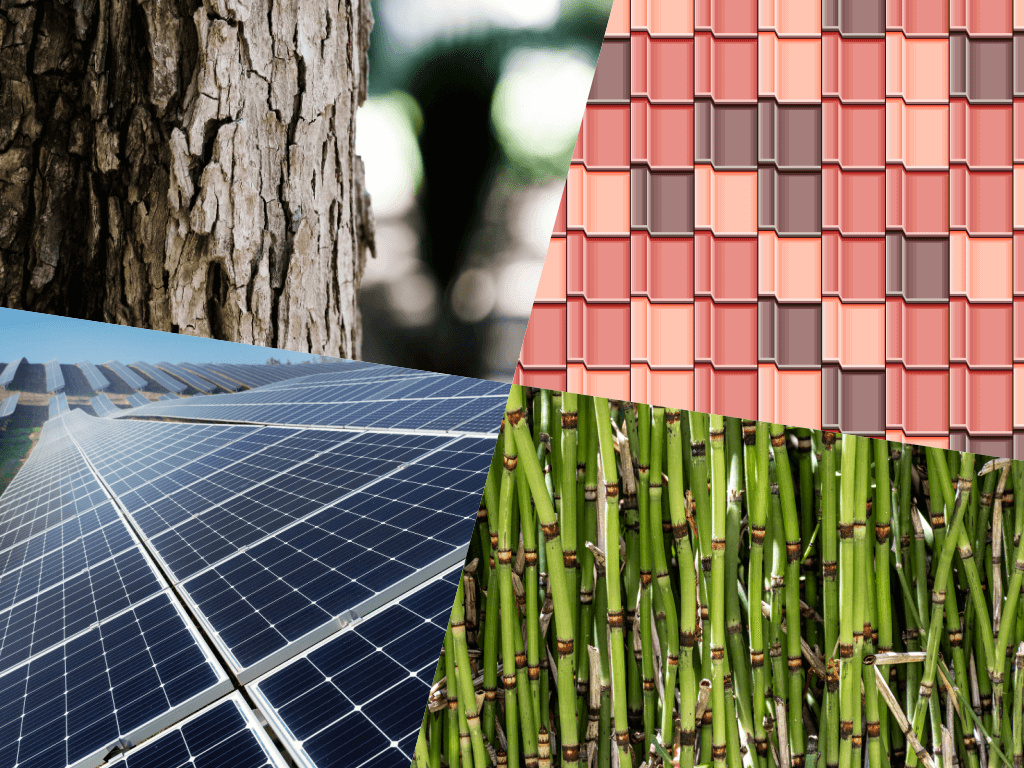
Bio-based Polyurethane Rigid Foam
This insulation material is derived from renewable plant-based sources, such as soy or castor oil, replacing traditional petroleum-based foams. It offers excellent thermal insulation properties, reducing energy consumption for heating and cooling. Plant-based polyurethane rigid foam supports sustainable building practices and aids in improving indoor comfort.
Rammed Earth
Rammed earth construction involves compacting layers of earth, like clay, sand, and gravel, into sturdy load-bearing walls. It is a highly sustainable building method, utilizing abundant natural materials and requiring minimal energy for construction. Rammed earth provides excellent thermal mass, absorbing heat during the day and releasing it slowly at night, maintaining a comfortable indoor temperature.
Hempcrete
Hempcrete is a bio-composite material made from hemp fibers, lime binder, and water. It is lightweight, non-toxic, and offers excellent thermal insulation properties. Hempcrete is breathable, regulating humidity levels and preventing mold growth. Additionally, hemp cultivation helps sequester carbon dioxide, making it a favorable option for environmentally conscious construction.
Cork
Cork is an excellent building material that comes from the bark of cork oak trees (Quercus suber). It is commonly used as an insulating material for walls, roofs, and floors due to its excellent thermal and acoustic properties. Its natural elasticity also makes it a great material for gaskets and seals. Its sound-absorbing properties create quieter and more comfortable living or working spaces. Cork is also resistant to moisture, mold, and rot, making it a durable and long-lasting option.
Ferrock
Ferrock is an innovative and carbon-negative construction material made from recycled items, such as steel dust and silica, mixed with a binding agent. During its curing process, Ferrock absorbs carbon dioxide, offsetting its carbon footprint and actively contributing to environmental sustainability.
Timbercrete
Timbercrete is a composite material combining recycled timber waste with concrete. This eco-friendly material reduces the demand for virgin materials and provides excellent thermal insulation. Timbercrete is commonly used for wall construction, promoting resource conservation and sustainable building practices.
Terrazzo
Terrazzo is a durable and sustainable flooring material made from a combination of recycled aggregates like glass, marble chips, and concrete. By utilizing recycled materials, terrazzo reduces the environmental impact of construction while offering a wide range of color and design options.
Smart Glass Windows
Smart glass windows can automatically adjust their tint or transparency based on external conditions. By optimizing natural light and controlling heat gain, these windows reduce the need for artificial lighting and cooling, promoting energy efficiency and lowering a building’s environmental impact.
Solar Panels
Solar panels harness renewable solar energy to generate electricity, reducing reliance on fossil fuels and lowering greenhouse gas emissions. By incorporating solar panels in buildings, sustainable practices are encouraged, and the reliance on traditional grid-based electricity is reduced.
Sustainable Packaging Materials

Packaging materials are a major contributor to pollution, choking our planet, little by little. While it’s impossible to curb out packaging completely, we can at least opt for biodegradable and compostable materials that significantly lower the burden of waste, as they break down naturally over time without leaving harmful residues. Some amazing green packaging alternatives are:
Recycled Packaging
Recycled plastic packaging materials are made from post-consumer plastics, diverting waste from landfills and preventing the need for new resources. They are commonly used in various industries, including food, retail, and shipping. It involves lower energy consumption during production and reduced carbon emissions while promoting a circular economy.
Biodegradable Packaging
Biodegradable packaging materials break down naturally into harmless substances, without leaving behind any poisonous residues. These materials are usually derived from plant-based sources such as corn, sugar cane, bamboo, etc., and compost within 180 days. Such type of packaging not only eliminates plastic pollution but also decreases dependence on fossil fuels and aids in soil enrichment from organic breakdown.
Corrugated Packaging
Corrugated packaging are cartons made from recycled cardboard, which is widely used for shipping boxes due to its excellent strength and versatility. It provides protection for goods during transportation and can be easily recycled, cutting down the need for virgin materials.
Mushroom Packaging
Mushroom packaging is an innovative material made from agricultural waste and mycelium, the root structure of mushrooms. It offers a biodegradable and sustainable alternative to traditional styrofoam packaging. It can be molded into various shapes, providing excellent cushioning and insulation for fragile items.
Cornstarch Packaging
Cornstarch packaging, also known as bioplastic, is derived from the starch of corn kernels. It is 100% compostable and carbon-neutral, offering a greener solution for single-use items like disposable cutlery, plates, and takeaway boxes.
Cellulose Packaging
Cellulose packaging is made from plant fibers, such as wood, hemp, or cotton. It is biodegradable and commonly used for food packaging as it has moisture-resistant properties. The material is both renewable and compostable, providing a sustainable alternative to conventional plastic packaging.
Glassine Packaging
Glassine is a smooth, transparent, and grease-resistant material made from wood pulp. It is commonly used for food packaging, envelopes, and protecting delicate items. Its renewable source, biodegradability, pH neutral, and acid-free features make it a conscious choice.
Green Cell Foam
Green cell foam is a plant-based compostable alternative to polystyrene foam. Made from US-grown non-GMO corn, it provides cushioning and insulation in the packaging of delicate products.
Kraft Paper
Kraft paper is a strong, recyclable, and biodegradable packaging material made from wood pulp. It is widely used for bags, wrapping, and corrugated boxes. Its sustainability stems from its renewable source and ability to be recycled multiple times.
Compostable Packaging Peanuts
These packaging peanuts are made from renewable plant materials and can be dissolved in water or composted. They can be efficiently used instead of traditional foam peanuts to support cushioning during shipping without contributing to plastic pollution.
Seaweed Packaging
Seaweed-based packaging is a biodegradable material made from seaweed extract. It is used for food and cosmetic packaging and serves as a low-impact substitute for petroleum-based plastics.
Sustainable Clothing Materials

In the realm of fashion, the quest for sustainability has sparked a growing interest in innovative fabrics that redefine the way we perceive and produce clothing. Sustainable clothing materials have emerged as a transformative force, challenging traditional practices and promoting a more eco-conscious approach to fashion. These cutting-edge materials are engineered to minimize environmental impact, conserve natural resources, and reduce waste throughout the product lifecycle. From groundbreaking plant-based textiles to upcycled fibers and biodegradable alternatives, this section explores the fascinating world of sustainable materials that are reshaping the future of fashion with their innovative and planet-friendly properties.
Organic Cotton
Organic cotton is grown suitable environment without the use of synthetic pesticides, fertilizers, and tons of water, promoting healthier soil and water conservation. Organic cotton makes the best soft, breathable, and eco-friendly clothing items like t-shirts, jeans, baby clothes, and bedding textiles. Its natural properties make it suitable for sensitive skin and reduce the risk of allergies or skin irritations.
Recycled Cotton
Recycled cotton is made from post-consumer or post-industrial cotton waste, averting textile waste from landfills. By using recycled cotton, the demand for virgin cotton production decreases, saving water and energy resources. It is utilized to create various clothing items, including hoodies, sweatshirts, and tote bags, reducing the carbon footprint of fashion production.
Linen
Linen is made from the fibers of the flax plant and is known for its lightweight, breathable, and durable nature. Flax is a resilient crop that requires less water compared to cotton, making linen a more sustainable choice. Due to its cooling properties, it is widely used for clothing like shirts, dresses, summer wear, and bedding textiles.
Hemp
Hemp is an easy-growing plant that thrives even with minimal water and pesticides during cultivation. It produces strong, durable fibers that can be used to create clothing like t-shirts, jeans, shoes, bags, etc. Hemp fabric becomes softer with each wash and is biodegradable, reducing its environmental impact.
Lyocell (Tencel)
Lyocell is a type of rayon made from wood pulp, often sourced from sustainably managed forests. The production process uses a high-tech system where solvents are recycled, minimizing waste and water usage. Lyocell is soft, breathable, and biodegradable, used to create clothing items like dresses, shirts, and activewear. Austrian conglomerate Lenzing AG is the leading producer of Tencel lyocell.
Modal
Modal is also a type of rayon made from beech tree pulp. It is known for its softness, smoothness, and ability to retain vibrant colors. Again, the company Lenzing AG makes the most sustainable modal, which manufactures it using a closed-loop process, reducing water and energy consumption. It is commonly used in dresses, tops, basics, loungewear, underwear, and other comfortable clothing items.
Woocoa
Woocoa is an innovative biofabricated material crafted from a blend of hemp and coconut fibers, skillfully treated with oyster mushroom enzymes within a controlled setting. Produced in a closed-loop cycle, Woocoa has a remarkably gentle, wool-like texture that is soft, and breathable.
Vegea
Vegea is a sustainable fabric made from grape pomace, the byproduct of winemaking. This vegan leather alternative is eco-friendly and can be used to make bags and accessories.
Cork
Cork is harvested from the bark of cork oak trees, which naturally regenerate after harvesting. It is lightweight, waterproof, and durable, perfect for shoes, bags, and accessories. Since cork is a renewable resource, it supports biodiversity and carbon sequestration.
Orange Fiber
Orange fiber is a sustainable textile made from citrus waste, such as orange peels. It offers a silky feel and is used to create luxurious, eco-friendly fabrics suitable for dresses, blouses, and scarves, reducing waste in the orange juice industry.
Piñatex
Piñatex is a sustainable fabric made from the fibers of pineapple leaves, a byproduct of the pineapple industry. This innovative material was developed by the company Ananas Anam and is biodegradable in nature. It is used in designing bags, shoes, laptop sleeves, and other accessories.
Recycled Polyester
Recycled Polyester is made from post-consumer plastic bottles and discarded polyester textiles, reducing the demand for virgin polyester production. The recycling process saves energy and minimizes greenhouse gas emissions, making it an eco-friendly choice for activewear, jackets, and outerwear.
Apple Leather
Apple leather is a vegan leather variety made from apple waste, such as peels and cores. This innovative material is soft and flexible and can be easily used to curate cruelty-free options for leather-like accessories and fashion items.
Mushroom Leather
Mushroom leather, also known as Mycelium leather or Mylo, is a biofabricated material made from mushroom roots and agricultural waste. It is quite versatile and is used for making everything from clothing, bags, and footwear to upholsteries.
Parblex
Parblex is a plant-based alternative to petroleum-based plastics, offering a more sustainable option for fashion accessories and packaging. It is made from potato waste and is both biodegradable and renewable, contributing to waste management in the food industry.
Econyl

Econyl is a regenerated nylon fiber made from post-consumer nylon waste, such as old fishing nets, industrial waste, carpets, etc. It was first introduced by the company Aquafil. The recycling process conserves resources and diverts waste from oceans and landfills. Econyl is used in swimwear, activewear, and fashion items, offering a durable and sustainable choice for performance wear.
Mango Leather
Mango leather is an innovative material made from discarded mangoes unfit for human consumption. It was invented by the Dutch company Fruit Leather Rotterdam and is lightweight, offering a distinctive texture, suitable for bags, wallets, and shoes.
Leaf Leather
Leaf leather is a type of cruelty-free and strong leather made from fallen teak leaves, which are collected, treated, dried, and layered to create a leather-like fabric. It is 100% biodegradable and can be crafted into unique wallets, belts, and fashion accents.
Spinnova
Spinnova is a sustainable fiber made from wood pulp and agricultural waste, using a green, water-based process. It eliminates the use of harmful chemicals, making it a more environmentally friendly option for clothing and textiles.
S.Cafe
S.Cafe is made from recycled coffee grounds. The coffee grounds are combined with recycled PET to create a moisture-wicking and odor-controlling fabric. S.Cafe is used in activewear, t-shirts, and outdoor apparel, offering a unique and eco-friendly performance fabric.
Ecovero
Ecovero is an innovative, updated version of viscose fiber made from certified renewable wood sources. The production process follows stringent environmental standards, reducing emissions and water usage. Ecovero is used in dresses, blouses, and comfortable everyday wear.
Cupro
Cupro is a regenerated fiber made from cotton linter, a cotton byproduct. The production process is more eco-friendly compared to conventional viscose and gives the sheen of silk, making it a good choice for clothing, lining, and accessories.
Deadstock Fabric
Deadstock fabric refers to surplus or leftover textiles from garment production factories that would otherwise be discarded. Using this scrap fabric immensely helps limit textile waste, while allowing brands to launch limited-edition clothing and accessories. This is because, since the materials are leftover pieces, they will all have different patterns and textures, so no two will ever be the same.
Bamboo
Bamboo is a renewable resource that requires minimal water and pesticides to thrive. Fabric made from bamboo is soft, breathable, and biodegradable, making it suitable for various clothing items, from t-shirts to underwear.
Certified Merino Wool
This type of Merino wool is sourced from ethically treated non-mulesed sheep and meets strict animal welfare and environmental standards. Merino wool is naturally biodegradable, temperature-regulating, and odor-resistant, making it a great choice for lightweight sweaters, basics, and socks. Certifications like Responsible Wool Standard, Woolmark, etc., are signs that the merino wool is cruelty-free.
Certified Alpaca Wool
Alpaca wool comes from alpaca herds that are native to Peru, adhering to responsible farming practices. This wool variety is soft, hypoallergenic, and eco-friendly, providing a luxurious and sustainable option for winter wear and accessories. Before investing in alpaca pieces, look for certifications like Responsible Alpaca Standard, World Fair Trade Organization, etc., to verify that they are sustainably and ethically produced.
Certified Cashmere
Certified Cashmere is sourced from the fine undercoat of cashmere goats. It is a luxurious and soft fabric that provides excellent insulation and is perfect for winter garments like sweaters, scarves, and coats. Certifications from the Sustainable Fibre Alliance, The Good Cashmere Standard, etc., ensure that the goats are raised ethically and that the production process meets sustainable and humane standards.
Vegetable-Tanned Leather
Unlike widespread chrome leather, vegetable-tanned leather is processed using natural tannins derived from plant sources like oak, chestnut, or mimosa. It is biodegradable, has a lower environmental impact, as it doesn’t contain harmful chemicals like chromium. Vegetable-tanned leather is commonly used for high-quality leather goods, such as belts, wallets, and shoes, providing durability and a unique aging patina. Always opt for responsibly sourced leather certified by ICEC or Leather Working Group.
Peace Silk
Also known as Ahimsa Silk, Peace Silk is produced without harming silkworms. This humane silk is soft and lustrous, ideal for luxurious clothing items like dresses, scarves, and lingerie. Peace Silk promotes the ethical treatment of animals and supports sustainable silk production practices.
Bananatex
Bananatex is a sustainable textile made from the fibers of banana plants. It is lightweight, durable, and water-resistant, making it suitable for backpacks, bags, and other accessories.
Sustainable Materials in Other Industries
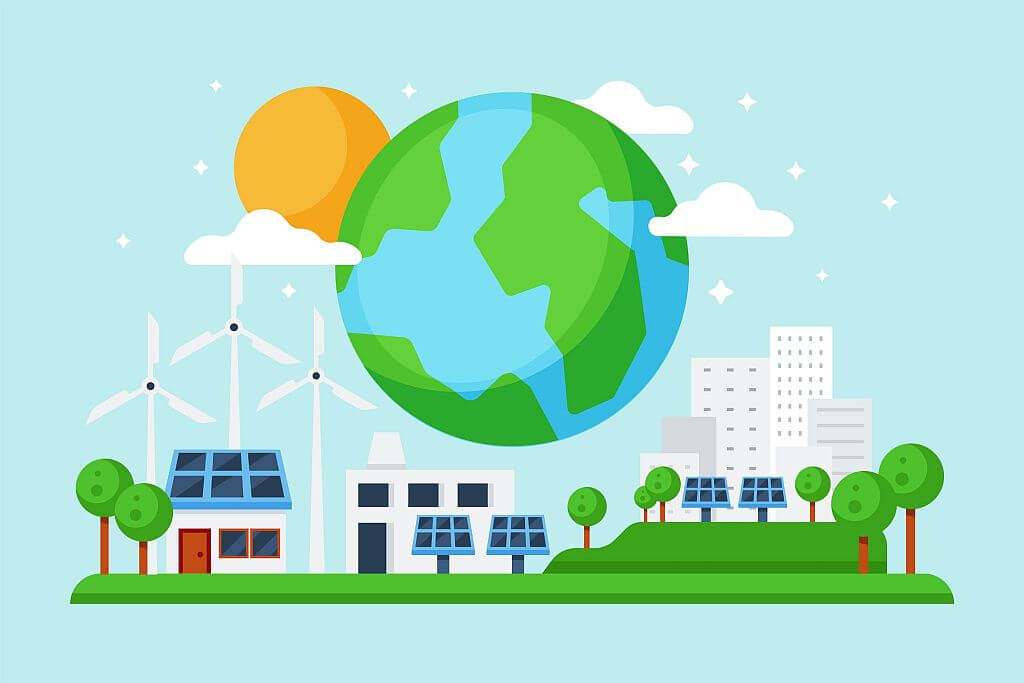
In various industries, the implementation of sustainability and the use of sustainable materials have been on the rise, marking a shift towards environmentally responsible practices. From eco-friendly packaging materials in the retail sector to renewable materials in fashion, the collective effort of individuals and companies to safeguard the planet is gaining momentum.
Sustainable Materials in Product Design and Manufacturing
Incorporating sustainable materials in product designing and manufacturing fosters responsibility and accountability across various industries. One significant area of focus is eco-friendly packaging materials, where alternatives to single-use plastics are gaining prominence. Today, numerous manufacturers are using materials like recycled paper, cardboard, and biodegradable plastics to offer eco-conscious packaging solutions.
Bioplastics and bio-composites are increasingly used for more sustainable product development, utilizing renewable resources and reducing dependency on fossil fuels. Derived from renewable resources like corn, sugarcane, or algae, bioplastics serve as substitutes for conventional plastics, providing biodegradability and reducing greenhouse gas emissions.
Furthermore, companies are adopting green manufacturing practices, such as energy-efficient technologies, waste reduction, and water recycling processes, to achieve their sustainability goals. Seeking certifications like ISO 14001 or LEED showcases a commitment to eco-friendly operations, ensuring products are manufactured with minimized environmental impact.
Sustainable Materials in Transportation and Mobility
The transportation and mobility sector is undergoing a remarkable transformation with the adoption of sustainable materials, paving the way for a greener future in how we move and travel. For example, Electric vehicles (EVs) stand out as a strong example that is revolutionizing the automotive industry. By replacing traditional internal combustion engines with electric motors, EVs significantly lowers CO2 emissions, air pollution, and reliance on petroleum and diesel. To top it all, the use of regenerative braking and energy-efficient batteries enhances their positive environmental impact.
The lightweight vehicle construction is another area where sustainable materials are in the limelight. Innovative materials like carbon fiber composites and advanced alloys are increasingly used to reduce vehicle weight, enhancing fuel efficiency and decreasing emissions. Plus, these materials offer strength and durability while being recyclable, contributing to resource conservation and circular economy principles.
Beyond individual transportation, sustainable materials are enhancing the efficiency of public transportation as well. Green public transit initiatives utilize responsible materials in bus bodies, train carriages, and other infrastructure. Biodegradable and recycled materials in seating, flooring, and interior components are further used to minimize the environmental impact while providing comfortable and safe commuting experiences.
Sustainable Materials in Consumer Electronics
Corporations working in the consumer electronics sector are exploring green alternatives to traditional materials, such as using recycled plastics, recycled alloys, or biodegradable materials in their product line. Sustainable materials are also being integrated into circuit boards and component manufacturing, diminishing the carbon footprint of electronic production.
However, one of the major challenges is the proper disposal and recycling of electronic waste (e-waste). With a lack of advanced recycling infrastructure and the trend of upgrading and replacing electronic devices regularly, landfills are overwhelmed with e-waste that takes thousands of years to biodegrade. Responsible e-waste management is crucial to prevent harmful environmental consequences. Companies and consumers are urged to play their part in recycling electronics responsibly to control the impact of e-waste on the environment.
To Sum Up…
In every industry, the adoption of sustainable materials is proving to be a game-changer, promoting a greener and more responsible approach to manufacturing and production. From construction to fashion, and transportation to consumer electronics, the potential of eco-friendly materials cannot be overstated. And as individuals and businesses, we hold the power to shape the future of our planet by prioritizing sustainable options in our everyday choices. Let’s prioritize the use of renewable, biodegradable, and recycled materials, advocating for a conscious world that we all want to leave behind for future generations.

